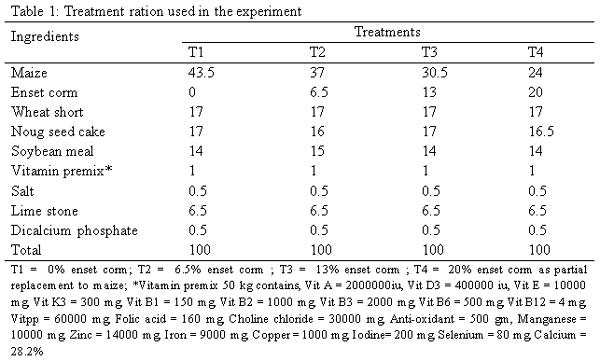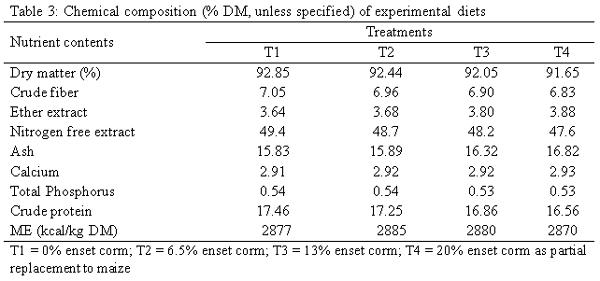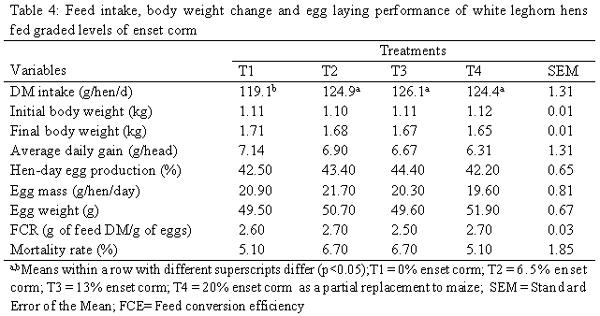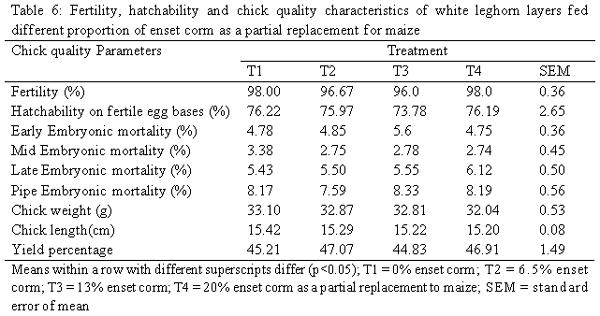The Effects of Partial Substitution of Maize with Enset (Ensete ventricosum) Corm on Production and Reproduction Performance of White Leghorn Layer
One hundred and eighty white leghorn layers were used to evaluate the effects of partial replacement of maize with enset (Ensete ventricosum) corm on production and reproduction performance. The layers were fed ration containing enset corm at levels of 0% (T1), 6.5% (T2), 13% (T3) and 20% (T4) to replace 0, 15, 30 and 45% of maize. The experiment was arranged in a completely randomized design with three replications and lasted 12 weeks. Hens were weighed at the start and end of the experiment. Data on dry matter intake, hen-day egg production, egg weight and egg mass were recorded daily. Egg quality parameters (egg shell weight and thickness, albumen weight and height, Haugh unit and egg yolk weight and color were determined at an interval of 7 days using 4 eggs per replicate. Enset corm contained 3.2% crude protein, 6.2% ether extract, 2.1% crude fibre and 1.8μg/100g beta-carotene. The mean daily DM intake of the group fed with T1 was significantly lower (P<0.05) compared with the groups fed with T2, T3 and T4, all of which had similar values. There was no significant difference (P>0.05) between all the treatment groups in average daily gain, hen-day egg production, egg mass, egg weight, feed conversion ratio, mortality rate, egg quality parameters, fertility, hatchability, embryonic mortality and chick quality characteristics. The net return gained from the inclusion of 13% enset corm to replace 30% of maize was more economical in terms of egg production and feed cost. Therefore, due to the year round availability and easy access by smallholder farmers in enset growing areas of Ethiopia, enset corm could safely and economically used in replacing 30% of maize in layers ration.
Keywords: Egg quality, Enset corm, Hen-day egg production, Layers, Replacement







Abdullah, R.B., Embong, W.K. and Soh, H.H. 2011. Biotechnology in animal production in developing countries. Proceedings of the 2nd International Conference on Agricultural and Animal Science, Pp: 88-91.
Abiola, S.S., Afolabi, A.O. and Dosunmu, O.J. 2008. Hatchability of chickens eggs as influenced by turning frequency in hurricane lantern incubator. Africa Journal of Biotechnology, 7 (23): 4310-4313.
Aderemi, F. A., Adenowo, T.K. and Oguntunji, A.O. 2012. Effect of Whole Cassava Meal on Performance and Egg Quality Characteristics of Layers. Journal of Agricultural Science, 4 (2):195-200.
Adugna Tolera. 2008. Feed Resource and Feeding Management. A manual for feed operators and development workers. Ethiopia sanitary and phyto-sanitary standards and livestock and meat marketing program (SPS-LMM). Addis Ababa, Ethiopia, Pp:38.
Afolayan, S.B., Dafwang, I.I., Sekoni, A. and Jegede, J.O. 2013. Effect of Dietary Maize substitution with sweet potato meal on performance of growers (10-12 weeks) and subsequent egg production (23-35 weeks). Asian Journal of Poultry Science, 7(2): 55-64.
Aina, A.B.J. and Fanimo, A. O. 1997. Substitution of Maize with Cassava and Sweet Potato Meal as the Energy Source in the Rations of Layer Birds. Journal of Tropical Agricultural Science, 20 (2): 163-167.
Ajebu Nurfeta, Abebash kebede and Aster Abebe. 2015. Evaluation of Replacement Value of Maize with Kocho on the Growth Performance and Carcass Characteristics of Broiler Hubbard Chickens. Journal of Science and Development, 3 (1):35-43.
Ajebu Nurfeta and Eik, L.O. 2014. Assessment of different levels of enset (Ensete ventricosum) corm as an energy supplement in sheep fed a basal diet of Rhodes grass hay, Hawasa, Ethiopia. Tropical Animal Health and Production, 46:905–911.
Ajebu Nurfeta, Adugna Tolera, Eik, L.O. and Sundstøl, F. 2008. Yield and mineral content of ten enset (Ensete ventricosum) varieties. Tropical Animal Health and Production, 40: 299-309.
Akinola, L.A.F., Oruwari, B.M. 2007. Response of laying hens to total dietary replacement of maize with cassava. Nigerian Journal of Animal Production, 34(2): 196-202.
Amerine, M.A., Pangborn, R.M. and Roessler, E.B. 1995. Principles of Sensory Evaluation of Food. Academic Press, New York.
Anaeto, M. and Adighibe, L.C. 2015. Cassava root meal as substitute for maize in layers ration. Brazilian Journal of Poultry Science, 13: 153-156.
AOAC. 2000. Association of Official Analytical Chemists, 16th ed. Official Methods of Analysis of AOAC International, Virginia. USA.
AOAC (Association of Official Analytical Chemist).1998. Official Methods of Analysis, 16thEdition, Washington, DC.
Atawodi, S. E., Mari, D., Atawodi, J. C. and Yahaya, Y. 2008. Assessment of Leucaena leucocephala leaves as feed supplement in laying hens. Africa Journal of Biotechnology, 7 (3): 317-321.
Bonnier, P and Kasper, H. 1990. Hatching Eggs by Hens or in an Incubator. Agrodok No. 34. Agromisa, Wageningen. 39p.
CSA (Central Statistical Agency). 2014. Agricultural sample survey Volume II. StatisticalBulletin No. 505. CSA, Addis Ababa, Ethiopia.
Etalem Tesfaye, Getachew Animut, Mengistu Urge and Tadelle Dessie. 2013. Cassava Root Chips and Moringa oleifera Leaf Meal as Alternative Feed Ingredients in Layers Ration. International Journal Poultry Science, 12 (5): 298-306.
Fafiolu, A. O., Oduguwa, O.O., Ikeobi, C. O. N. and Onwuka, C. F. I. 2006. Utilization of malted sorghum sprout in the diet of rearing pullets and laying hen. Animal Archive, (55) 212: 361-371.
Gura, S. 2008. Industrial livestock production and its impact on smallholders in developing countries. Consultancy report to the League for Pastoral Peoples and Endogenous Livestock Development (www.pastoralpeoples.org), Germany.
Haftu Kebede, Mengistu Urge and Kefelegn Kebede. 2014. Effect of replacing maize with malted barley grain on fertility, hatchability, embryonic mortality and chick quality of white leghorn layers. Global Journal of Poultry Farming and Vaccination, 2 (3):121-125.
Haugh, R.R. 1937. The Haugh unit for measuring egg quality. U.S. Egg Poultry Magazine, 43: 552-553,572-573. .
Hunton, P. 1995. Egg production, processing and marketing. World Poultry Science, Elsevier, Tokyo. 457-480p.
Ladokun, O.A., Aderemi, F.A. and Tewe, O.O. 2007. Sweet potato as feed resource for layer production in Nigeria. African Crop Science Conference Proceedings, 8: 585-588.
Lakhotia, R.L. 2002. Poultry Eggs. Agro bios (India). Jodhbur. 342p.
Leeson, S. and Summers, J.D. 2005. Commercial Poultry Nutrition. 3rd ed. Nottingham University Press, Canada. 398p.
Medegu, C. I., Raji, A. O., Igwebuike, J. U. and Barwa, E. 2011. Alternative cereal grains and cereal by-products as sources of energy in poultry diets. Research Opinions in Animal and Veterinary Sciences, 1(8): 530-542.
Meijerhof, R. 2006. Chick size matters. World Poultry Science, 22:30–31.
Meijerhof, R. 2005. What counts for chick quality? Hybro B.V P.O. Box 30, 5830 AA, Boxmeer, Netherlands.
Mihret Aregy and Mengistu Urge. 2012. Effect of substituting maize with sundried and ground Cassava tuber on egg production, quality, fertility and hatchability of white leghorn hens. MSc. thesis. Haramaya University, Ethiopia.
Mohammed Beyan, Gabel, M. and Karlsson, L.M. 2013. Nutritive values of the drought tolerant food and fodder crop enset. Africa Journal of Agricultural Research, 8 (20): 2327-2333.
Molenaar, R. I., Reijrink, R., Meijerhof and Van den Brand, H. 2009. Relationship between hatchling length and weight on later productive performance in broilers. Hatch Tech B. V., adaptation Physiology Group, Wageningen University, 6700 AH Wageningen, The Netherlands.
Ngiki, Y.U., Igwebuike, J.U., Morupp, S.M. 2014. Effect of replacing maize with cassava root-leaf meal mixture on the performance of broiler chickens. International Journal of Science and Technology, 3(6): 352-362.
Odunsi, A.A., Ogunleke, M.O., Alagbe, O.S. and Ajani, T.O. 2002. Effect of feeding Gliricidia Sepium leaf meal on the performance and egg quality of layers. International Journal of Poultry Science, (1):26-28.
Penda, P.C. 1996. Shape and texture. In: Text book on egg and poultry Technology, PP.57.
Raphael, K.J., Kouabena, K., Herve, M.K., Alexis, T., Yacouba, M. 2013. Effect of substituting maize with cassava root meal on laying performances of local barred-chicken under improved management conditions in Cameroon. Livestock Research and Rural Development, 25(10).
Saentaweesuk, S., Kanto, U., Juttupornpong, S. and Harinsut, P. 2000. Substitution of cassava meal for corn in layer diets. In: Proceedings of the 38th Kasetsart University Conference, Kasetsart University, Bangkok, Thailand, 1-4 February, 2000.
Samuel Sahle. 2008. The epidemiology and management options of chocolate spot disease (Botrytis fabae sard) on Faba bean (Vicia faba L.) in Northern Ethiopia. PhD Dissertation, Haramaya University, Ethiopia. 175p.
Senkoylu, N., Samli, H. E., Akyurek, H., Agma, A. and Yasar, S. 2005. Use of high levels of full-fat soybeans in laying hen diets. Journal of Applied Poultry Research, 14:32-37.
Smith, H. 2003. Cassava as substitute for cereals in livestock rations. Available from: htttp://www.rada.gov.jm/hidden-menu-items/item/665-cassava-as-a-substitute-for-cereal-in-livestock-rations.
SAS (Statistical Software System). 2009. SAS User’s Guide, Statistics. SAS Institute, Inc., Cary, NC. USA.
Tadelle Dessie, Nigussie Dana, Alemu Yami and Peters, K.J. 2002. The feed resource base and its potentials for increased poultry production in Etiopia. World Poultry Science Journal, 58: 77-87.
Tekalign Yirgu, Etalem Tesfaye, Getinet Assefa. 2017. Poultry Feed Resources and Coping Mechanisms of Challenges in Sidama Zone, Southern Ethiopia. Food Science and Quality Management, 60:77-87.
Upton, M. 1979. Farm Management in Africa, the Principal of Production and Planning, Oxford University Press, p.380.
Wiseman, J., 1987. Feeding of Non-Ruminant Livestock. Butter worth and C. Ltd. p.370.
Wu, G, Bryant, M.M., Gunawardana, P., Roland, D.A. 2007. Effect of nutrient density on performance, egg components, egg solids, egg quality, and profits in eight commercial leghorn strain during phase I. Poultry Science, 86:691-697.
Zebib Abisa and Mengistu Urge. 2012. Effects of substituting sorghum for maize on egg production, quality, fertility and hatchability of white leghorn layers. MSc. thesis. Haramaya University, Ethiopia.









.jpg&w=3840&q=75)